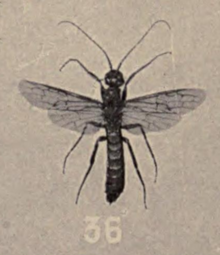Xeris
Xeris is a genus of horntails found in North America and Eurasia. Achille Costa circumscribed the genus in 1894.
| Xeris | |
|---|---|
 | |
| Type species: X spectrum | |
 | |
| X. morrisoni. | |
| Scientific classification | |
| Kingdom: | Animalia |
| Phylum: | Arthropoda |
| Class: | Insecta |
| Order: | Hymenoptera |
| Family: | Siricidae |
| Genus: | Xeris A. Costa, 1894 |
| Type species | |
| Ichneumon spectrum Linnaeus, 1758 | |
| Diversity | |
| 16 species | |
| Synonyms | |
| |
Synonyms
In 1987, Malkiat S. Saini and Devinder Singh circumscribed a new genus, Neoxeris upon their description of a new species, which they called Neoxeris melanocephala.[1] In 2012, N. melanocephala was transferred to Xeris, making Neoxeris a junior synonym.[2] X. melanocephalus was later synonymized with X. himalayensis.[3]
Description
Characteristic features of Xeris compared to other genera of Siricidae genera include: a hind wing with which lacks a cell cup, a small vertical ridge behind the eye, and a metatibial spur.[3]:36
Distribution
Xeris species are found in North America and Eurasia. In North America, they're found from the boreal forests in Alaska and Canada south through Chiapas in southern Mexico. They are found in temperate and boreal regions of Eurasia as well as mountains of southern Eurasia including Morocco, India, China, and Taiwan.[3]:42
Species
As of 2015, Xeris consists of sixteen species:[3]
X. caudatus

Xeris caudatus (Cresson, 1865) was initially placed in the genus Urocerus by Ezra Townsend Cresson in his species description. Its type locality is the Colorado Territory.[4]
X. chiricahua
Xeris chiricahua Smith, 2012 was described by David R. Smith. Its type locality is Rustler Park, Chiricahua Mountains, Arizona.[2]:251–252
X. cobosi
Xeris cobosi Viedma & Suárez, 1961 was first described by M. G. de Viedma and F. J. Suárez as a subspecies of X. spectrum. It was moved to the species level in 2015. Its type locality is Tizi-Ifri, Morocco.[3]:48–50
X. degrooti
Xeris degrooti Goulet, 2015 was described in 2015 by Henri Goulet. It is named in honor of Peter de Groot. Its type locality is Pennington County, South Dakota.[3]:51–53
X. himalayensis
Xeris himalayensis Bradley, 1934 was described by James Chester Bradley in 1934. Its type locality is Deoban, Chakrata, India.[5] In 2015, it became considered the senior synonym of X. melanocephalus (Saini and Singh, 1987), whose type locality is Dalhousie, India.[3]:53–57
X. indecisus
Xeris indecisus (MacGillivray, 1893) was initially described by MacGillivray as a species in Urocerus. Its type locality is near Olympia, Washington.[6] T. C. Maa classified it as a subspecies of X. morrisoni in 1949, but in 2012 it was reinstated to the species level.[2]:253–258
X. malaisei
Xeris malaisei Maa, 1949 was initially described as a subspecies of X. spectrum, but was promoted to the species level in 2015.[3]:63–67
X. melancholicus

Xeris melancholicus (Westwood, 1874) was described by John O. Westwood, who placed it in the genus Sirex. He listed the type locality as "America Septentrionalis".[7]
X. morrisoni
Xeris morrisoni (Cresson, 1880) was described by Ezra Townsend Cresson in 1880; he initially placed it in the genus Urocerus.[8]:35
X. pallicoxae
Xeris pallicoxae Goulet, 2015 was described by Henri Goulet in 2015. The specific name means "pale coxae".[3]:74–80
X. spectrum
Xeris spectrum (Linnaeus, 1758) was described by Carl Linnaeus in 1758.[9] Costa designated it to be the type species of Xeris.
X. tarsalis
Xeris tarsalis (Cresson, 1880) was described by Ezra Townsend Cresson in 1880. Its type locality is Washington Territory, and Cresson initially placed it in the genus Urocerus.[8]:52
X. tropicalis
Xeris tropicalis Goulet, 2012 was described by Henri Goulet in 2012. Its type locality is San Cristobal de las Casas, in southern Mexico; the specific name tropicalis "tropical" reflects its habitat.[2]:267–286
X. umbra
Xeris umbra Goulet, 2015 was described by Henri Goulet in 2015; its type locality is Yunnan Province, China and its name umbra "shadow" refers to the species' dark color.[3]:95–98
X. xanthoceros
Xeris xanthoceros Goulet, 2015 was described by Henri Goulet in 2015. Its specific name means "yellow horn", referring to the female's flagellum. The type locality is Yunnan, China.[3]:95–98
X. xylocola
Xeris xylocola Goulet, 2015 was described by Henri Goulet in 2015. The specific name means "living in wood". Its type locality is Houaphanh Province, Laos.[3]:98–100
References
- Saini, Malkiat S.; Singh, Devinder (1987). "A new genus and a new species of Siricinae (Insecta, Hymenoptera, Siricidae) from India with a revised key to its world genera". Zoologica Scripta. 16 (2): 177–180. doi:10.1111/j.1463-6409.1987.tb00064.x.
- Schiff, Nathan M.; Goulet, Henri; Smith, David R.; Boudreault, Caroline; Wilson, A. Dan; Scheffler, Brian E. (2012). "Siricidae (Hymenoptera: Symphyta: Siricoidea) of the Western Hemisphere". Canadian Journal of Arthropod Identification. 21: 1–305. doi:10.3752/cjai.2012.21.
- Coulet, Henri; Boudreauult, Caroline; Schiff, Nathan M. (2015). "Revision of the World species of Xeris Costa (Hymenoptera: Siricidae)". Canadian Journal of Arthropod Identification. 28: 1–127. doi:10.3752/cjai.2015.28.
- Cresson, E. T. (1865). "Catalogue of Hymenoptera in the Collection of the Entomological Society of Philadelphia, from Colorado Territory". Proceedings of the Entomological Society of Philadelphia. 4: 247–248.
- Bradley, J. Chester (1934). "A New Species of Xeris (Hymenoptera-Siricidae) from the Himalayas" (PDF). Records of the Indian Museum. 36 (2): 145. Archived (PDF) from the original on 21 July 2017.
- MacGillivray, Alex. D. (1893). "Washington Tenthredinidæ and Uroceridæ". The Canadian Entomologist. 25 (10): 243. doi:10.4039/Ent25237-10. hdl:2027/hvd.32044107197519.
- Westwood, J. O. (1874). "Order—Hymenoptera". Thesaurus Entomologicus Oxoniensis. Oxford: Clarendon. p. 116; Pl. 21, Fig. 8.
- Cresson, E. T. (1880). "Descriptions of New North American Hymenoptera in the Collection of the American Entomological Society". Transactions of the American Entomological Society and Proceedings of the Entomological Section of the Academy of Natural Sciences. 8 (1–2): 1–52. JSTOR 25076383.
- Linnæus, Carolus (1758). "Insecta Hymenoptera. Ichneumon". Systema Naturæ (10th ed.). Holmia: Laurentius Salvius. p. 560.